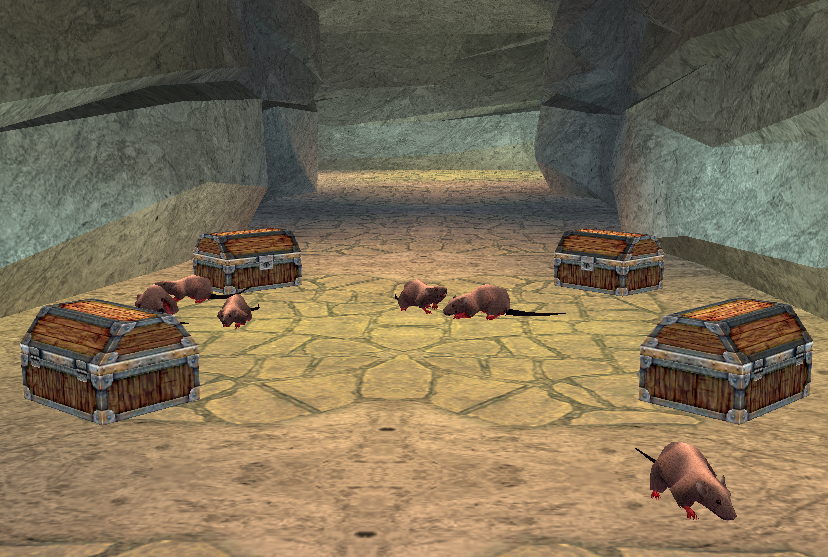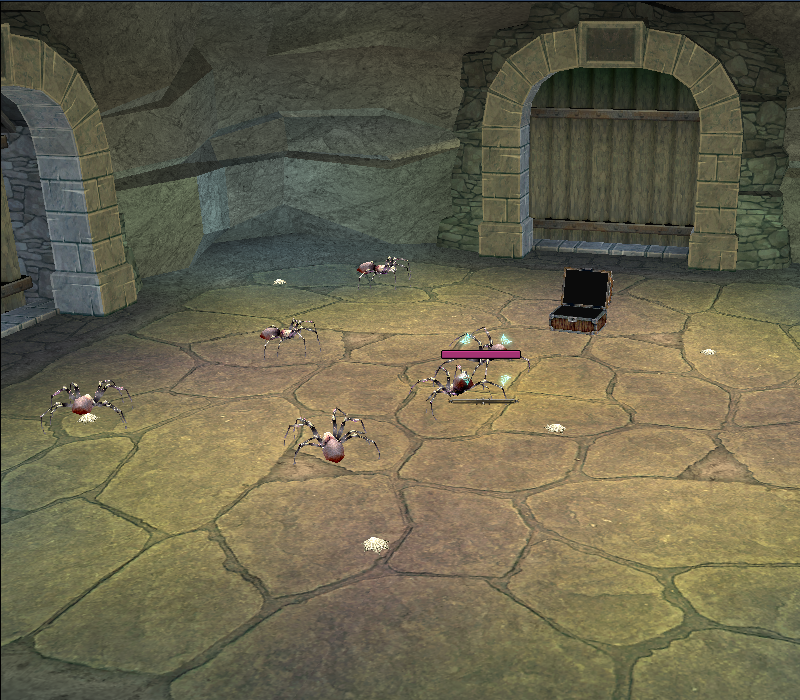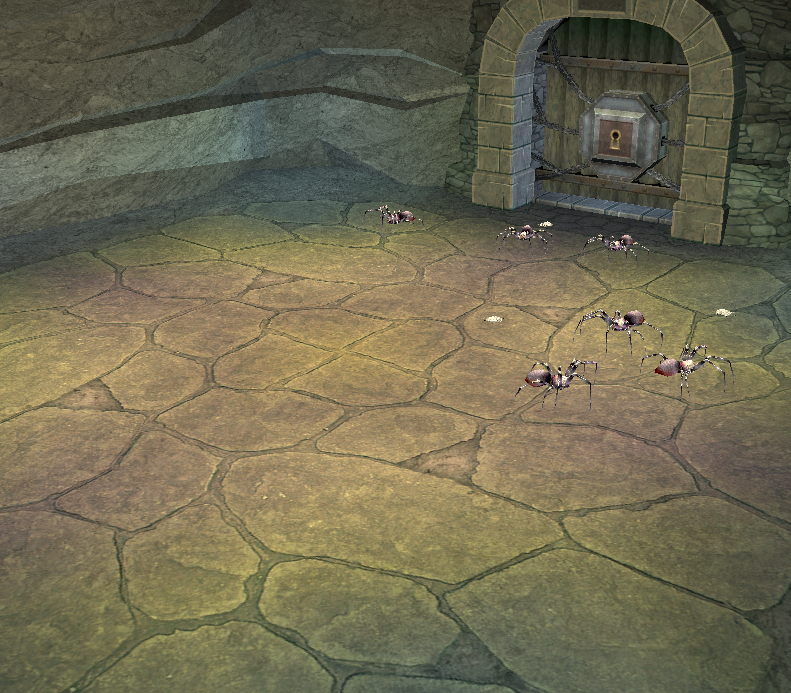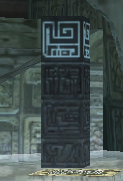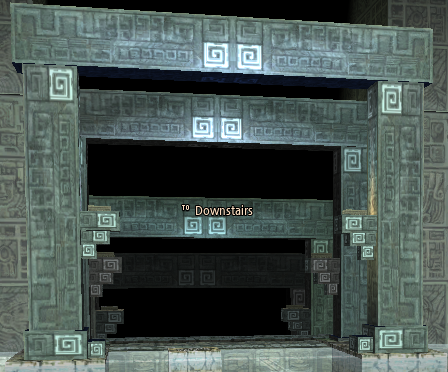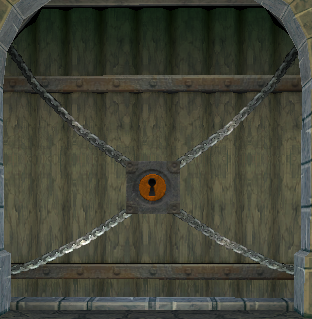Mabinogi World Wiki is brought to you by Coty C., 808idiotz, our other patrons, and contributors like you!!
Want to make the wiki better? Contribute towards getting larger projects done on our Patreon!
Dungeon Room Types
For an overview of dungeons, see Dungeons.
Chest Room
The room contains a single treasure chest placed randomly in the room. Opening the chest reveals treasure, typically gold, potions, bandages, or firewood, but also seals all doors to the room and spawns monsters. Party members who are outside the room maybe enter by clicking a door. Once all mobs are defeated, the doors will open.
Chest rooms come in five sub-types. If you are attempting a dungeon that has more than one of these sub-types, you won't know which sub-type you are dealing with until you open the chest.
Standard Chest Room
Usually there will be one or three waves of monsters, but Peaca Intermediate has some spawn patterns with two waves. One monster in the final wave has a key, which will open a subsequent door and which is required to complete the floor. Killing that monster will cause all players in the dungeon to be awarded a copy of that key.
The monsters do not display any of the unusual behaviours described in the following forms.
In most Ulaid dungeons chest rooms are always of this form, the exception being castle dungeons.
Recovery Chest Room
- Monsters will alternate between being "active" and "resting". The time spent resting is typically 5~10 seconds and the time active is typically 10~15 seconds. The resting time will be identical in length for all monsters in the room, as will the active time, but these times may vary between rooms.
- When resting, monsters will usually drop any aggro, and will recover up to 50% of their HP, but not wounds.
- You cannot target or attack the monsters when they are resting.
- Monsters that are resting CAN be infected with Mirage Missile when touched.
- If you are in the attack animation when a monster starts resting, your attack will still hit them, but only for melee attacks.
- If a monster is in an attack animation when it is due to start resting, the attack will complete normally, delaying the switch to resting status.
- If a monster is knocked into deadly status before it starts resting, it will still have that status when resting stops.
- In a synchronous room, all monsters enter the rest state at the same time. In an asynshronous room, the monsters are subudivided into two (or three?) groups that enter their resting state at two (or three?) different times. Often the two different groups are two different types of monsters, but there are exceptions where the grouping is independent of the monster type. The delay between the two groups going into the resting state can differ by room, suggesting it is randomly selected. It may be that the synchronous room is really just an asynchronous room where the random selection resulted in the delay between the two groups being zero. If this is true, the spawn patterns for synchronous and asynchronous recovery rooms should be identical. Initially we should collect data separately for synchronous and asynchronous spawns, so we can test if the resulting spawn pattern lists are identical.
- If contributing asynchronous spawn pattern data to this wiki, please use braces to indicate the two groups. For example: {Young stone mask x8} + {Young Emerald Beetle x6}
These rooms are encounterd in
- Ulaid Castle Dungeons.
- In Karu Forest Ruins, Longa Desert Ruins and Maiz Prairie Ruins in Iria.
The castle dungeons were released much earlier than the Iria continent and Recovery Chest Rooms in the Castle Dungeons demonstrate simpler behaviour than those in Iria. In a castle dungeon a recovery chest room will have either:
- Exactly one type of monster. Then all monsters will enter and leave the rest state at the same time.
- Exactly two types of monsters. There will never be a time when all monsters are resting. Rather, the monsters will cycle through three states:
- All monsters of the first type are resting while those of the second type are active.
- All monsters are active.
- All monsters of the second type are resting while those of the first type are active.
In Iria, these rooms show more variety.
- There can be times when all monsters are resting.
- When the monsters are split into two groups that enter the rest state at different times, the subdivision is not always based on the type of monster.
Slowly Mobbing Chest Room
- The room spawns one wave of monsters consting of three groups.
- One group of monsters spawns in the active state and is ready to attack. The other two groups are resting and cannot be attacked, but will wake up in turn at fixed time intervals. If the first group has not been killed before the second group awakens, this can create a dangerously mobby situation for small parties.
- Occasionally all three groups of monsters spawn in the rest state, with the first group becoming active a few seconds later. This might just be due to lag.
- Often the three groups are three different types of monsters, but there are exceptions.
- If contributing spawn patterns to the wiki, please indicate the 3 groups using braces, listing them in the order in which they become active.
- These rooms are encounterd in Karu Forest Ruins, Longa Desert Ruins and Maiz Prairie Ruins in Iria.
Vanishing Chest Room
- Opening the chest will cause up to 12 monsters to spawn.
- The monsters are divided into three groups. Each group may contain up to 4 monsters. Often the monsters within a group are of the same type.
- After a set period of time, the first group, which spawned near the centre of the room, will vanish.
- A little later, the second group, which spawned further out from the centre, will vanish.
- The third group, which spawned in the corners of the room, will not vanish and must be defeated.
- Weaker parties may wish to use Crisis Escape to avoid fighting the monsters until the first group vanishes. Elves may use hide, which may last long enough for both the first and second group to vanish.
- If contributing spawn patterns to the wiki, please indicate the 3 groups using braces, listing them in the order in which they vanish.
- These rooms are encounterd in Karu Forest Ruins, Longa Desert Ruins and Maiz Prairie Ruins in Iria.
Roulette Chest Room
- Opening the chest will cause monsters to spawn in the resting state and 4 switches will appear, one in each corner of the room.
- The monsters cannot be attacked. To progress, click one of the 4 switches.
- Until someone collects data on the frequency of following outcomes, it will remain unclear whether all outcomes are always possible in a roulette room.
- Clicking a switch may have no effect. If this happens, try a different switch. It seems that at most one switch has no effect.
- Alternatively, clicking a switch will cause all 4 switches to disappear, some or all of the monsters may vanish, and any remaining monsters will switch to active. The room doors will reopen when all monsters have either vanished or been defeated.
- If contributing spawn patterns to the wiki, please list both the monsters present before clicking a switch and those remaining afterwards.
- These rooms are encounterd in Karu Forest Ruins, Longa Desert Ruins and Maiz Prairie Ruins in Iria.
Roulette One-switch Room
- This is a variation on the Roulette Chest Room, with the initial treasure replaced by a single switch in the middle of the room.
- Hitting the switch close the doors to the room and monsters will spawn in the resting state.
- The monsters cannot be attacked.
- To progress, hit the switch a second time. This may cause some or all of the monsters to vanish and any remaining monsters to become active.
- The room doors will reopen when all monsters have either vanished or been defeated.
- If contributing spawn patterns to the wiki, please list both the monsters present before clicking a switch and those remaining afterwards.
- Due to paucity of data, it is not yet clear whether Roulette One-switch Rooms and Roulette Chest Rooms select from the same set of spawn patterns.
Four-Switch Room
This room contains 4 switches, one in each corner, and a closed exit. One switch, referred to here as the correct switch, will open the closed exit. The other three switches will cause mobs to spawn. Once the correct switch is hit, any switches that haven't yet been hit will be deactivated. Any spawned mobs need not be defeated - the correct switch will still open the exit while mobs are spawned. When mobs spawn, the room entrance does NOT close, so weaker players seeking to avoid multi-agro may choose to retreat via the entrance and pick off mobs one at a time from a distance.
In Uladh dungeons, a switch is usually an orb, a spherical bulb atop a vertical stem. The bulb lights up when hit. When the correct switch is hit, the other switches do not change appearance.
In Iria dungeons the switch can also be a pillar of stone or ice which disappears into the ground when struck. Hitting the correct switch may also cause any remaining switches to disappear.
Mimic Room
Initial Form
The room contains 4 chests, one in each corner. One of these is a treasure chest containing a key which opens the exit to the room, and may sometimes also contain treasure. When that chest is opened, all players in the dungeon receive a copy of the key. The other three chests are resting mimics, identical in appearance to the treasure chest. The room might also contain other mobs, possibly including more resting mimics randomly scattered about the room, but the key will always be in one of the chests in the 4 corners.
When listing spawn patterns on the dungeon's page, the preferred format is to explicitly list the treasure chest first, the mimics second, and any other mobs after that. For example:
Treasure chest + 5 mimics + 4 brown snakes.
Useful methods for distinguishing the treasure chest from the resting mimics include:
- Try to Windmill it. You can windmill mimics, but not the treasure chest.
- Use Stomp, which will waken mimics without drawing agro.
- Summon a pet with stun, freeze or knockback effects. These affect mimics but not the treasure chest.
- Load Shooting Rush. Mimics in the attack path will have a target arrow above them. The treasure chest won't.
See Mimic (Family) for more hints.
To minimise the number of mobs the software needs to track, the mobs in mimic rooms (and mimic corridor clusters and pre-deployed rooms, discussed below) are NOT all spawned when the player starts the floor. Rather, when it creates the instance of that floor, it only places the treasure chest in the room. There is a trigger line shortly before the mimic room and when a player crosses that line it causes the mobs in the room to spawn. When the trigger point is close enough to the room, the player can hear the sound effect of the mobs spawning. Players who have their camera zoomed out may even catch a glance of the room when it only contains the treasure chest, and be able to go straight to it rather than being distracted by the mimics. Players experiencing lag may on occasion even manage to open the tresure chest before any monsters spawn in the room.
Later Variation
This variation can occur in Castle Dungeons and in Iria dungeons, but in those locations it is still much rarer than the common form described above.
In this variation the treasure chest will still be in one of the four corner positions, but the other 3 corner positions are filled by monsters other than mimics. By the time you enter the room, those three monsters may have wandered a little from their spawn point, but it is usually obvious which monsters started in the corners. Usually there will also be other monsters randomly placed in the room. These other monsters may include mimics, but their position is usually far enough from the corners that they will not be confused with the treasure chest. Thus when you encounter this variation you can simply open the treasure chest in the corner and progress straight to the exit, trying to avoid engaging any of the monsters.
When listing spawn patterns on the dungeon's wiki page, please identify the corner positions. For example:
{Corners: Treasure chest + Stone Hound x3} + {Random position: Stone Mimic x4 + Stone Hound the Dubious x3}
Mimic Corridor Cluster
These are similar to a mimic room, but the monsters spawn in a corridor rather than in a dungeon room. This results in the monsters being placed in a much smaller area, so when there are much more than 4 chests/mimics, they may overlap, making it difficult to see exactly how many there are. In the Ulaid version, the four corner chests can still usually be recognised by their location at the 4 corners of a square. The treasure chest may be harder to identify in the Iria variation if the other 3 corner positions are occupied by monsters that wander from their spawn point. Look for a chest oriented at 45 degrees to the wall.
Since these are not in a room, the key obtained will open a subsequent door rather than a locked exit of the current location.
It is not clear whether mimic rooms and mimic corrider cluster draw their spawn patterns from a single set. Historically, this wiki grouped these two types together when listing spawn patterns. When data has been collected separately for the two types, it was clear that there was significant overlap, but there were differences, and sample sizes were not large enough to ascertain whether there really were two separate underlying lists, or whether there was just one list with some of the rare spawn patterns not being encountered for both types.
While it is a rare occurrence, in Math normal and Rabbie Intermediate - and possibly in other dungeons that contain reward chests at the end of dead end corridors - it is possible for a mimic corridor cluster to be placed the end of a dead end corridor. At first glance, this may give the impression that this mimic corridor cluster has 2 treasure chests. However, on opening the two treasure chests the contents make it clear that one of them is a normal dead end reward chest rather than part of the mimic corridor cluster.
Pre-deployed Room
A room which already contain mobs when the player reaches it. The distinguishing feature of this room type is that the player does NOT need to defeat the mobs. Rather, the player can just "skip" the room by running past the mobs, ideally on a fast mount to minimise the chance of attracting agro. The room's exit may be open or closed. If closed, the key to open it should have been obained earlier on that floor.
As noted above, to minimise the number of mobs the software needs to track, the mobs in a pre-deployed room are not spawned until a player crosses a trigger line shortly before it. Players experiencing lag may have the unpleasant experience of entering an apparently empty room, only to have the mobs spawn all around them after they enter.
While the label "Pre-deployed Room" is now entrenched in the wiki and will be hard to change, it is not a great name, since mimic rooms also share the feature of monsters being deployed before the player enters the room, (ignoring lag effects). The defining feature of this room type is not that it is "pre-deployed". The key feaure is that player can quickly pass through the room without engaging with any monsters.
Treasure Chamber
- This is a room containing 9 treasure chests arranged in a 3 x 3 square grid.
- A floor may contain 0 or 1 treasure rooms.
- When a floor contains a treasure room, it will contain exactly 3 4-switch rooms. In each of those rooms, for the 3 "wrong" switches that cause a wave of monsters to spawn, one of the monsters in that wave will drop a Treasure Chamber Chest Key when killed. Thus, while 9 keys are theoretically available, to obtain all 9, players would need to hit the 3 wrong switches before hitting the correct switch, and do that in all 3 of the 4-switch rooms.
- Each key will open any chest but can only be used once. A chest may contain valuables, most commonly money, potions or bandages. Also, a chest may be empty and opening it will cause all doors to the room to close and mobs will spawn. Defeating all the mobs will cause the doors to reopen.
- Some of the 4-switch rooms may occur after the treasure chamber room, so the player would need to backtrack to use any keys obtained. Given the low rewards obtained from chests, backtracking more than a room or two is not usually worth the effort.
- While it is not mentioned in the patch notes, it seems that the 7-Oct-2021 dungeon update removed treasure chambers from most Ulaid basic, intermediate and advanced dungeons, making them much rarer.
Herb Room
- A herb room contains three randomly selected herbs.
- Historically, herb rooms have been otherwise empty. Following the 7-Oct-2021 dungeon update a herb room in Ciar Intermediate Dungeon was found with pre-deployed monsters. Attempts to replicate this have failed. It is not clear whether this is an ongoing feature with low probability or whether it arose from a bug that has been fixed.
Ore Deposit Room/Corridor
These are documented on the Barri Dungeon page since they occur only in that dungeon.
